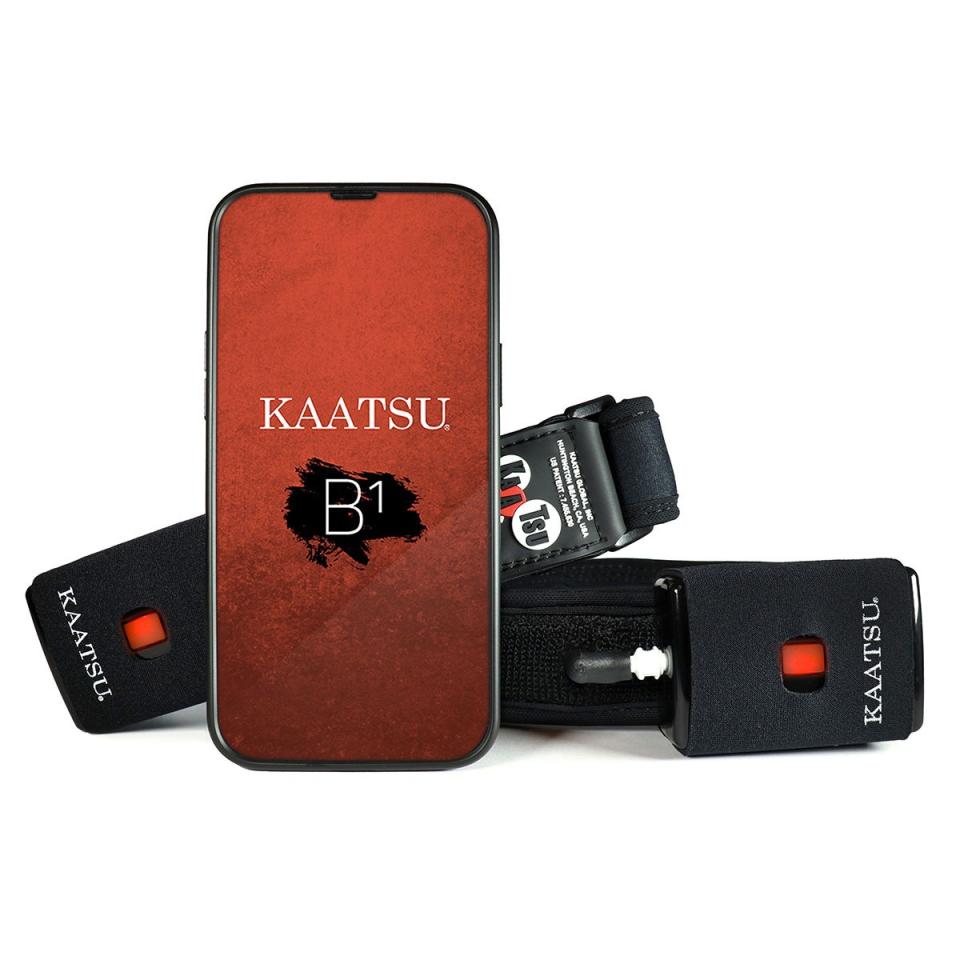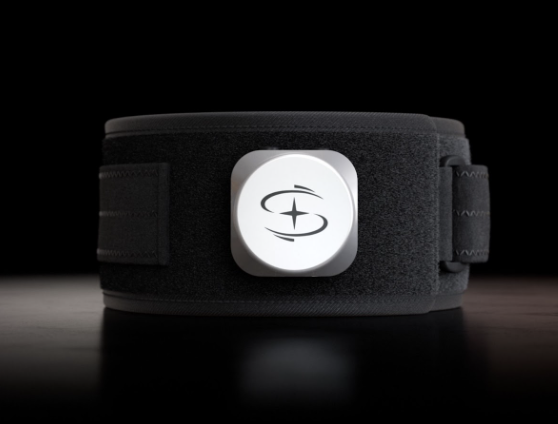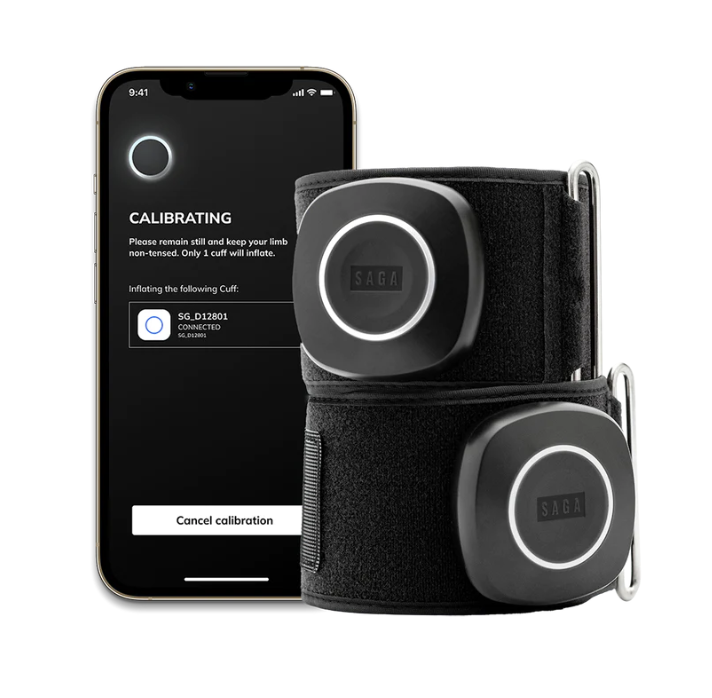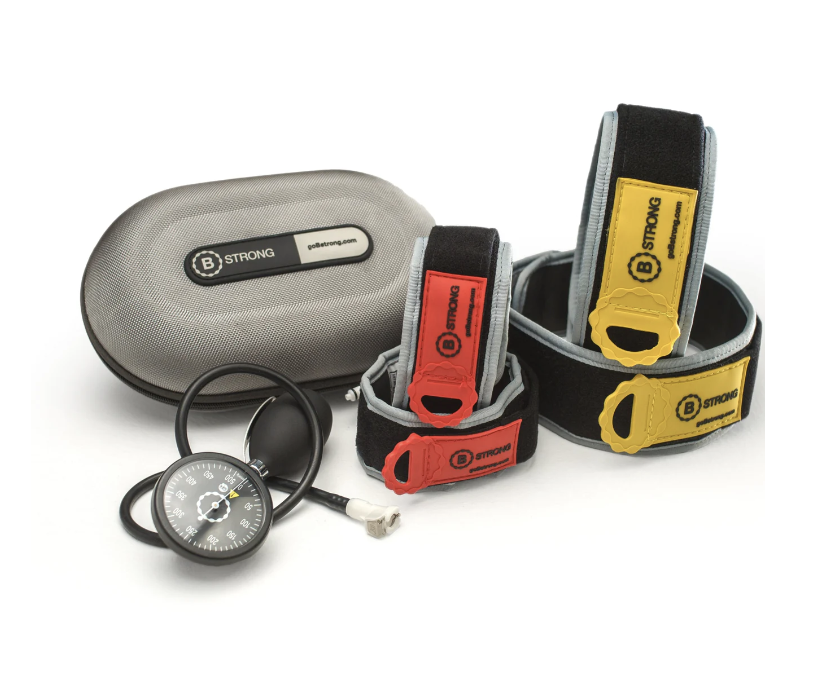What is Blood Flow Restriction Training? The Actual Science Behind This Oddly Efficient Conditioning Method

Our editors independently select the products we recommend. We may earn a commission on items bought through our links.
Deadlifting hundreds of pounds and bicep curling 60’s is a great way to bulk up if the cup of youth still runneth into joint mobility and bone density, but time takes its toll on everyone eventually. Heavy lifting taxes the shit out of the central nervous system and also becomes harder and harder with age.
Today's Top Deals
Blood flow restriction training, a method that uses pneumatic compression to strategically cut off some blood flow and tax muscles with less weight, was originally designed to make it easier for older folks to exercise. It works muscles to a similar extent with a fraction of the load, and is now being used by Olympic athletes for efficient training and experimental gym bros like Mark Wahlberg looking to maintain bulk without overexerting the joints.
The concept of getting yoked with half the weight, and a lower likelihood of pulling something, certainly sounds ideal. But it’s fair to be skeptical of anything that sounds like a physiological cheat code. If there’s no pain can there really be gain? Yes, it turns out, there can be.
What Is Blood Flow Restriction?
In the late 1960s, Dr. Yoshiaki Sato created the KAATSU training method in Japan which came to be known as modern-day blood flow restriction. The practice wasn’t widespread outside of Japan until 2008, when it started to become commonplace amongst Olympic swimmers, eventually making headlines after Michael Andrew tourniquet-ed his biceps at the 2021 Tokyo games.
The primary vision for KAATSU was not to build muscle, Steven Munatones, CEO and co-founder of KAATSU told SPY. “Dr. Sato was really ahead of the game in saying we have to apply a preventative approach to address the diseases the aging population was facing, such as diabetes.” BFR partially restricts blood flow from the heart to the limbs and fully restricts blood from the limbs to the heart. This puts muscles in a low-oxygen environment during exercise and essentially tricks the body into building muscle.
“My addition to KAATSU was taking Dr. Sato’s original concept and making a commercial product that anybody can use anywhere.” Thus, the KAATSU technology applies a slightly different approach to blood flow restriction. Since safety was at the top of the priority list, Dr. Sato and his team studied KAATSU on more than 12,000 individuals to ensure they developed a safe and efficient product. Its efficiency caught the attention of NFL and NBA teams, NASA, the Navy, and even the Department of Defense.
Janelle Fleites, PT, DPT, explained that the partially restricted blood flow “causes a build-up of metabolic waste, further causing metabolic stress. This build-up triggers a physiological response that is proven to stimulate muscle growth.”
The research on this method is not sweeping, but it’s not a new practice with meager backing either. A randomized control trial out of China of 25 healthy, young men showed increased levels of human growth hormone and testosterone after exercise while using BFR. An eight-week study in 2002 investigated the muscle function impact of vascular occlusion combined with low-resistance training in 17 highly-trained rugby players. Researchers saw an increase in muscle size, strength and endurance.
Dr. Lynass added that the effects go beyond just the muscles. “We’ve seen that it affects everything up and down the limb, creating a systemic effect.”
Another study in 2010 looked at how BFR impacted skeletal muscle strength in 37 healthy men between the ages 50 and 64 years. The findings revealed that the group that used BFR had nearly as great of an improvement in leg muscle strength as the regular resistance training group and significantly higher improvement than the control group.
FDA-approved BFR units are expensive, and while there are cheaper dupes available on Amazon that may help enlarge bicep veins during exercise, the ones below are the only units SPY editors trust to exercise this method safely and effectively.

BEST OVERALL
KAATSU B1
Buy Now
KAATSU’s B1 is their most advanced option that utilizes an interchangeable unit placed on the cuffs that connects to a smartphone. The pressure of each cuff can be adjusted via the app and personal usage data can be shared with a trainer or physical therapist.
Munatones said that individuals can select a pre-calculated pressure, but can also apply a custom one when needed. What makes KAATSU different from other BFR tools is that it inflates and deflates intermittently every 30 seconds as opposed to being inflated for an extended period. This is designed to make KAATSU safer for anyone, and it can be worn even during sedentary periods such as watching TV. Munatones recommends wearing it about 30 minutes at a time up to two to three times a day.

RUNNER UP
Smart Tools SmartCuffs 4.0
Pre-Order Now
Smart Tools’SmartCuffs® 4.0 is being released at the end of March 2023 and is designed to take the guesswork out of how tight to pump the cuffs. “They’ve made this very user-friendly for people, it’s very comfortable and easy to clean,” Dr. Lynass said, adding that she would feel most comfortable sending a client home with SmartCuffs, as it’s an FDA Class 1 device.
They use a proprietary artificial intelligence algorithm to calibrate the correct limb occlusion pressure for each individual’s arms and legs, and the wireless system connects to your smartphone via Bluetooth, so it’s easy to inflate and deflate between sets or exercises.

BEST FOR BEGINNERS
SAGA Blood Flow Restriction
Buy Now
SAGA is a great BFR option for beginners. The tile device on each cuff connects to a smartphone and automatically detects limb pressure and calculates individual arterial occlusion pressure (AOP), which is the amount of pressure required to fully occlude arterial blood flow. SAGA makes it easy to select the right percentage for training. Dr. Fleites recommended SPY readers aim for 80% of AOP for legs and up to 50% for arms for best results. The pressure is calibrated in just a few minutes, and there’s also the option to adjust it manually.

BEST MANUAL OPTION
BStrong Blood Flow Restriction
Buy Now
Buy Now On Amazon
In a testimonial for this BStrong package, Mark Wahlberg said “I get results. I’m getting twice the pump in half the time and getting more results, and I’ve been able to work twice as hard.”
This BStrong BFR package includes two cuffs for the leg and two cuffs for the arm in three different sizes, and the brand can custom-make extra small or extra-large models as needed. Since this system comes with a manual pump, be sure to get advice from an expert to pump it up to an appropriate and safe level.
Are BFR Bands Worth the Squeeze?
There’s emerging science behind this practice and even with the elevated price tags of the FDA-approved blood flow restriction cuffs, they’re still less than an average set of adjustable dumbbells. They deliver more for less effort and when lifting the right load, and may get to the desired hypertrophic effect with less strain. This all depends on each individual’s training plan and goals, but for busy people who want to spend a normal amount of time in the gym, efficiency is one of its primary selling points.
On days when time is limited, instead of having to spend 60 to 90 minutes lifting in the gym, a 30-minute body weight or low-level resistance training session with BFR can yield similar benefits. And if one is recovering from an injury, under the guidance of a licensed physical therapist or healthcare practitioner it could be a great way to build back strength safely.
Frequently Asked Questions About Blood Flow Restriction
Is Blood Flow Restriction Dangerous?
BFR is not dangerous under the supervision of a medical professional trained in the methodology. Dr. Lauren Lynass, physical therapist and certified strength and conditioning specialist, told SPY that it’s essential to consult with someone who’s certified in using BFR or a healthcare professional before using it, because there are contraindications that may put you at higher risk of injury.
“Some people may experience bruising, not very high at all, some may experience numbness,” she said adding that “studies have shown that contraindications are more likely with people with the history or deep venous thrombosis, blood clots, pregnancy, varicose veins, high blood pressure or any sort of cardiovascular disease, too.”
What Type of Exercise Can I Do While Wearing a BFR System?
Both lower and upper body exercises are fair game with a BFR system and will yield benefits. They can be worn during strength training and cardiovascular exercise as well. Basically, anything that uses muscles will be impacted and has the potential for benefit.
“You can train both in the same day, just know that your whole body will be pretty tired,” Dr. Lynass said, adding that “you should let fatigue be your guide.”
Is a Blood Flow Restriction System Comfortable to Wear?
“It’s not the most comfortable,” Dr. Fleites said, noting that the wider the cuff is the more comfortable it is. “Your muscles will get really fatigued toward the third and fourth set and you may notice a change in color because of the lack of blood flow, but I never had an issue where a patient had to stop due to too much discomfort.”
Who Should Use a Blood Flow Restriction System as Part of Their Training?
It’s commonly used during injury rehabilitation or any situation in which a heavy load is not accessible. “It’s really good after, for example, a knee injury to help build muscle back up,” said Michael Hamlin, personal trainer.
“I can see it still being used as part of a recovery session during [the] off-season with athletes when you’re still getting maximum recruitment [of muscle] without having so much stress on the muscle, but you’re still taking the muscle to fatigue and achieve metabolic stress,” Dr. Fleites said.
For the general public, it can serve as a complementary workout in between heavy resistance training days, but should not replace it altogether, as training with heavy weights still comes with massive benefits. It’s also a great option when you don’t have a lot of time to go to the gym but still want to get a good pump, Dr. Lynass said adding “it may be a good idea to do a bodyweight BFR training one time a week.”
To Continue Reading…
The 10 Best Adjustable Dumbbells, Tested and Reviewed by Athletes
10 Beginner-Friendly Strength Training Moves for Getting Over Your Gym-timidation
The 10 Best Exercises for Burning Calories and Shedding Pounds
More Top Deals from SPY
Best of SPY

